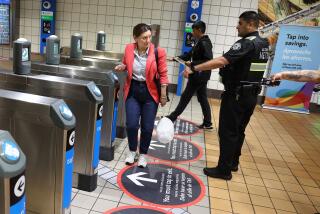Paramedic Wins Trial Run for Blood-Sugar Test
- Share via
Michael Kinkade is obsessed with a pocket-sized meter.
The Carlsbad paramedic is convinced that the meter, which measures blood-sugar levels, would help him do a better job in many emergency situations, including ministering to unconscious stroke or diabetes victims. Now he is trying to convince county medical officials to allow use of the device.
Because symptoms for both can be similar, it can be difficult for paramedics to determine whether a person is unconscious as a result of low blood sugar--as in the case of a diabetic--or is suffering a stroke, said Kinkade, who is also a firefighter with the Carlsbad Fire Department.
Administering dextrose, a form of glucose, can quickly resolve the diabetic’s problem, but recent studies have shown that such treatment may cause brain damage to the stroke victim.
On the other hand, failing to raise a diabetic’s low blood-sugar level could lead to a coma, Kinkade said.
“By using the blood-glucose meter, we can know right away whether the person’s blood-sugar level is high or low,” he said. “If the person is a diabetic, we can give proper care immediately at the scene.”
Kinkade has received approval from the San Diego County Emergency Medical Services advisory committee, which helps set medical care protocol, to begin a two- to three-month pilot program that will allow Carlsbad, Oceanside and Vista fire department paramedics to use the meters. He also has the backing of the San Diego County Paramedic Assn.
During the test period, paramedics will measure a patient’s blood-sugar level by using the meter and by traditional hospital laboratory tests. The results of the measurements--about 400 test cases--will be compared to determine the meter’s accuracy, Kinkade said.
Hopes for Continued Use
If the device is proven accurate, Kinkade hopes county officials will include its use in the protocol, which is scheduled to be updated in September.
But some members of the medical community and diabetics are questioning whether a test period for a device already proven accurate and reliable is needed. Some have also criticized the county for requiring the test but not paying its $2,000 cost.
The meter has been widely employed by diabetics for more than five years to monitor blood-sugar level and by hospital staffs nationwide. Besides hospital personnel, paramedics in many states have used the device, Kinkade said. The meter is also used by paramedics in Orange and Riverside counties.
Those who advocate the meter’s immediate use argue that, the longer the county’s paramedics are forbidden to use the device, the greater the danger to the public.
‘Biggest Nightmare’
“Becoming unconscious as a result of low blood sugar, that’s the biggest nightmare every diabetic has,” said Pat Gallagher, a diabetic who hosts a radio program, “Living With Diabetes.”
“If and when that happens, we put our trust in a paramedic to take care of us adequately,” Gallagher said. “It’s upsetting to know that they don’t even have these meters. How can they tell whether we’re suffering from low blood sugar? They’re playing Russian roulette.
“The best thing that could happen is if the county allowed the paramedics to use these meters right away,” Gallagher said.
Dr. Steven Edelman, an endocrinologist who specializes in diabetes treatment at UCSD Medical center, agrees with Gallagher.
“My personal opinion is that a pilot program is not needed,” Edelman said. “It’s already been proven effective. This is a problem of bureaucracy and medical ignorance.”
Gallagher is also disturbed that Emergency Medical Services will not pay for the pilot program. Unless Kinkade can raise $2,000, the testing program could be indefinitely postponed. Kinkade, who said he is working on raising the money, hopes to begin the program in mid-March.
But Patti Murrin, responsible for paramedic services and who serves on the Emergency Medical Services advisory committee’s staff, said it is not the county’s role to finance medical research. The county Emergency Medical Services is a regulatory agency that is primarily responsible for enforcing and regulating state statutes for emergency medical service, Murrin said.
“If we were to undertake this we would have go through a budget process and a formal bidding process to get the equipment,” Murrin said. “It would delay the process even more.”
Murrin confirmed that meters have been used by paramedics elsewhere, but with mixed results, she said. As a result, Murrin said, the test is necessary to prove the meter’s reliability to local emergency-room doctors.
Diabetics’ concern about paramedics operating without meters is unwarranted, Murrin said.
“Current protocol is to give an unconscious person dextrose, so the diabetic will get the needed sugar,” Murrin said. “They don’t have to worry.”
In fact, the test program was approved more out of concern for the stroke victim, Murrin said.
In a study of 107 stroke patients done by and published in the American Journal of Medicine in April 1983, Dr. William A. Pulsinelli of Cornell University Medical College found that elevated sugar levels in the brain during a stroke greatly enhance the extent and degree of brain damage.
Stroke Caution
The study concluded, “Glucose-containing infusions should be avoided in the immediate treatment of patients with acute or progressive stroke.”
“If a person is lying in the street, and I don’t have a clue as to why he’s unconscious, and there’s no family member around to give me any medical background, according to protocol I would begin cardiac monitoring . . . and give him dextrose,” said Kinkade.
“The signs and symptoms of a person who’s having a stroke and who’s unconscious because of hypoglycemia (low-blood sugar) can be exactly the same,” he said. “By giving dextrose to a person who’s suffering a stroke, we may be compromising patient care.”
No Official Position
Although the American Diabetes Assn. does not have an official position on the use of meters by emergency personnel, the organization approves the meter’s use by individuals and in hospital emergency rooms, a representative said.
“It is an issue that we will be looking at closely,” said Janet Schroyer, a spokeswoman for the ADA’s state affiliate office.
Edelman, the diabetes specialist, favors the immediate use of the meters and says it would assure prompt medical care for diabetics.
Often, diabetics do not wear medical bracelets, leaving paramedics unsure whether the unconscious person is suffering from the disease, Edelman said. A simple blood reading would allow the paramedic to act immediately.
Favors Test Program
Although Sharon Henry, paramedic operations manager for Hartson Medical Services, agrees that meters should be used, she also favors conducting a pilot program. Hartson provides emergency care to nine cities in the county and employs nearly 50% of the county’s 314 paramedics.
“I know it sounds bureaucratic, but I believe it needs to be tested,” Henry said. “What you use at home, or in the hospital, is very different from what you can use out on the field. You don’t have those controlled environments. Because it works at home, it doesn’t mean it’ll work for us.
“But I hope the approval process doesn’t take too long,” Henry said. “As long as they’re reliable, it makes a lot of sense to use them.”
More to Read
Sign up for Essential California
The most important California stories and recommendations in your inbox every morning.
You may occasionally receive promotional content from the Los Angeles Times.













